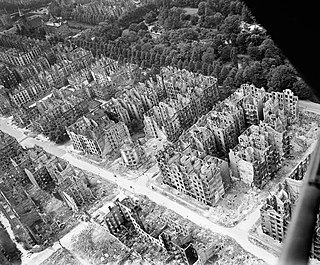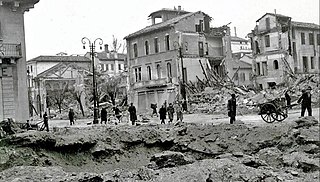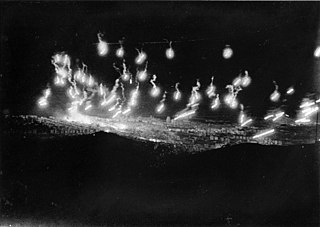


The first bombing of Amsterdam in the Second World War, and the only attack on the city center, occurred on 11 May 1940 when a German plane bombed the Blauwburgwal neighborhood and completely destroyed seven buildings, killing 44 and wounding 79.



The first bombing of Amsterdam in the Second World War, and the only attack on the city center, occurred on 11 May 1940 when a German plane bombed the Blauwburgwal neighborhood and completely destroyed seven buildings, killing 44 and wounding 79.
A Junkers Ju 88 bomber dropped four bombs on the neighborhood, one of which levelled seven buildings and a café near the Herengracht. [1] Two other bombs exploded in the canals and a fourth landed in the water without exploding, where it remained. [2]
The bombing was an isolated event and did not have any apparent military goal. Two possible explanations have been given: [3]
Dutch newspapers reported the bombing at the time, but the major bombing of Rotterdam a few days later received more attention, and further coverage was banned by the German occupiers. The killed civilians were buried without being specifically identified as bombing victims, and were only identified in 2016. [3]
The bombing is remembered every year. [4] In May 2020, a memorial plaque with the victims' names was unveiled in the neighborhood. [5]

Carpet bombing, also known as saturation bombing, is a large area bombardment done in a progressive manner to inflict damage in every part of a selected area of land. The phrase evokes the image of explosions completely covering an area, in the same way that a carpet covers a floor. Carpet bombing is usually achieved by dropping many unguided bombs.

The Allied bombing of Hamburg during World War II included numerous attacks on civilians and civic infrastructure. As a large city and industrial centre, Hamburg's shipyards, U-boat pens, and the Hamburg-Harburg area oil refineries were attacked throughout the war.

World War II (1939–1945) involved sustained strategic bombing of railways, harbours, cities, workers' and civilian housing, and industrial districts in enemy territory. Strategic bombing as a military strategy is distinct both from close air support of ground forces and from tactical air power. During World War II, many military strategists of air power believed that air forces could win major victories by attacking industrial and political infrastructure, rather than purely military targets. Strategic bombing often involved bombing areas inhabited by civilians, and some campaigns were deliberately designed to target civilian populations in order to terrorize them and disrupt their usual activities. International law at the outset of World War II did not specifically forbid the aerial bombardment of cities – despite the prior occurrence of such bombing during World War I (1914–1918), the Spanish Civil War (1936–1939), and the Second Sino-Japanese War (1937–1945).
Big Week or Operation Argument was a sequence of raids by the United States Army Air Forces and RAF Bomber Command from 20 to 25 February 1944, as part of the Combined Bomber Offensive against Nazi Germany. The planners intended to attack the German aircraft industry to lure the Luftwaffe into a decisive battle where the Luftwaffe could be damaged so badly that the Allies would achieve air superiority and would ensure success of the Normandy landings later in 1944.

The bombing of Osaka during World War II was part of the strategic bombing campaign waged by the United States against military and civilian targets and population centers in Japan. It first took place from the middle of the night on March 13, 1945, to the early morning of the next day. There were also bomb raids on June 1, 6, 7, 15, 26, July 10, 24, and August 14, the last day of the war. It is said that more than 10,000 civilians died in these bombings in Osaka, Japan.

During World War II, the Estonian capital Tallinn suffered from many instances of aerial bombing by the Soviet air force and the German Luftwaffe. The first bombings by Luftwaffe occurred during the Summer War of 1941 as part of Operation Barbarossa. A number of Soviet bombing missions to then German-occupied Tallinn followed in 1942–1944.

The bombing of the Bezuidenhout took place on 3 March 1945, when the Royal Air Force mistakenly bombed the Bezuidenhout neighbourhood in the Dutch city of The Hague resulting in the death of 532 citizens.

As the main economic and industrial center in Italy, and the country's second largest city, Milan was subjected to heavy bombing during World War II, being the most bombed city in Northern Italy and one of the most bombed cities in the country.

The bombing of Nijmegen on 22 February 1944 was a target-of-opportunity aerial bombing raid by the United States Army Air Forces on the city of Nijmegen in the Netherlands, then occupied by Nazi Germany. In terms of the number of victims, it was one of the largest bombardments of a Dutch city during World War II. Officially, nearly 800 people were killed by accident due to inaccurate bombing, but because people in hiding were not counted, the actual death toll was likely higher. A large part of the historic city centre was destroyed, including Saint Steven's Church. Saint Augustine's Church and Nijmegen railway station were heavily damaged as well.

On the night of 9/10 March 1945, the United States Army Air Forces (USAAF) conducted a devastating firebombing raid on Tokyo, the Japanese capital city. This attack was code-named Operation Meetinghouse by the USAAF and is known as the Great Tokyo Air Raid in Japan. Bombs dropped from 279 Boeing B-29 Superfortress heavy bombers burned out much of eastern Tokyo. More than 90,000 and possibly over 100,000 Japanese people were killed, mostly civilians, and one million were left homeless, making it the most destructive single air attack in human history. The Japanese air and civil defenses proved largely inadequate; 14 American aircraft and 96 airmen were lost.

The Blauwburgwal is a canal in Amsterdam between the Singel and the Herengracht. It is close to the city center and part of the west Grachtengordel.

The bombing of Cagliari was a series of attacks by the United States Army Air Force and the Royal Air Force on the Italian city of Cagliari, the regional capital of Sardinia, during World War II. The raids, aimed at destroying the port facilities and airfields of Cagliari, also resulted in the destruction of most of the city.

The bombing of Vicenza was a series of attacks by the United States Army Air Force and the Royal Air Force on the Italian city of Vicenza, Veneto, during World War II. The purpose of these raids was to disable the city's marshalling yard and airport, but the bombing also caused considerable collateral damage to the city itself.

Owing to its importance as an industrial center, home to Fiat and several other industries engaged in war production, Turin, the regional capital of Piedmont, suffered over a hundred raids by the Allied air forces during World War II; the Piedmontese capital was thus among the most bombed cities in Northern Italy, suffering damage to about 40% of its housing stock, and over 2,000 victims among its population.

During World War II the Italian city of Bologna, the regional capital and largest city of Emilia-Romagna, suffered nearly a hundred air raids by the Royal Air Force and the USAAF, mostly aimed at disabling its strategically important marshalling yards, used for the movements of German troops and supplies between Northeastern Italy and central Italy. These raids destroyed or damaged almost half of the city, and caused nearly 2,500 victims among its population.

Owing to the importance of its port and industries, the Italian port city of Genoa, the regional capital and largest city of Liguria, was heavily bombarded by both Allied air and naval forces during Second World War, suffering heavy damage.

The bombing of Padua was a series of attacks by the United States Army Air Force and the Royal Air Force on the Italian city of Padua, Veneto, during World War II. These raids were aimed at disabling Padua's marshalling yard, but also resulted in heavy damage to the city and civilian casualties.
The bombing of Sukabumi was an aerial bombing of the city of Sukabumi, West Java in the Dutch East Indies during the Dutch East Indies campaign of World War II. On the morning of Friday, 6 March 1942, a formation of seven Imperial Japanese aircraft indiscriminately bombed and strafed government buildings, infrastructure, and residential areas, resulting in the deaths of around 70 people and destruction throughout the city.

The Allied bombings of Amsterdam-Noord took place in July 1943 during the German occupation of the Netherlands in World War II. Three strategic bombing attacks by Allied Forces were aimed at the former Fokker Aircraft Factory in the northern part of Amsterdam, which was of interest as the factory was confiscated by the Nazis and employees were forced to produce aircraft for the Luftwaffe. However, only 7 out of the 326 bombs from these three airstrikes hit their target, while the others fell on the surrounding residential area, resulting in the loss of more than 206 lives in total. The attacks were the most damaging and deadly bombardment of Amsterdam during the Second World War, and the most disastrous airstrike the city has ever endured. As these were Allied attacks, the losses and trauma caused by the event have always been a sensitive and painful topic for the citizens of Amsterdam-Noord.